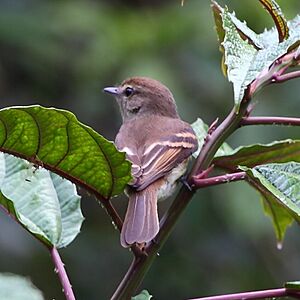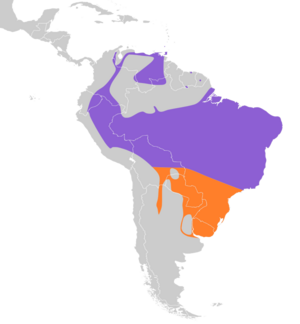Euler's flycatcher facts for kids
Quick facts for kids Enferrujado |
|
|---|---|
 |
|
| Euler's flycatcher in Bertioga, São Paulo State, Brazil | |
| Conservation status | |
| Scientific classification | |
| Genus: |
Lathrotriccus
|
| Species: |
euleri
|
 |
|
| Synonyms | |
|
Empidonax euleri |
|
The Euler's flycatcher (scientific name: Lathrotriccus euleri) is a small bird that belongs to the tyrant flycatcher family. These birds are known for catching insects while flying. You can find them in South America, especially east of the Andes mountains. They live from Colombia and Venezuela all the way south to Bolivia and Argentina. They also live on the island of Trinidad. They used to live on Grenada too, but sadly, they are no longer found there. This bird is named after a Swiss scientist who studied birds, Carl Euler.
Contents
What Does the Euler's Flycatcher Look Like?
Euler's flycatchers look a lot like another group of birds called Empidonax flycatchers. In the past, scientists even thought they were part of that group! However, they have some key differences in their bodies and DNA.
These small birds are about 12.7 centimeters (5 inches) long. They weigh around 10 to 11 grams (about 0.35 to 0.39 ounces), which is super light!
- Top part: Their back and head are olive-brown.
- Wings: Their wings are a darker brown and have two dull, light brown stripes.
- Underneath: Their throat and chest are grey, while their belly is a pale yellow.
- Eyes: They have a white ring around their eyes, but no stripe above them.
Both male and female Euler's flycatchers look very similar. There are also different types of Euler's flycatchers, called "races," which might have slightly different shades of color on their bodies. When they call out, it sounds like a loud, rough chee-chi-wi-wi-wi.
Where Do They Live and What Do They Do?
You can find Euler's flycatchers living in forests. They usually stay in the lower and middle parts of the trees. These birds are quite shy and hard to spot. They tend to hide among the plants and branches.
From their hidden spots, they suddenly fly out to catch insects. They are also able to hover in the air to pick insects off plants. However, they don't do this as often as they dart out to catch flying bugs.
Reproduction and Life Cycle
In the southern parts of their home range, especially in subtropical mountain forests, Euler's flycatchers have their babies during the rainy summer months. They are busiest building nests and laying eggs from late October to November, and this can continue until January or February.
Their nest is shaped like an open cup. They build it using grass, leaves, and plant fibers. They usually place the nest in a fork of a tree branch, a few meters above the ground. Sometimes, they might even build it high up in the tree's crown.
- Eggs: A female Euler's flycatcher usually lays 2 to 3 white eggs. These eggs have reddish-brown spots, mostly at the wider end. Each egg weighs about 1.7 grams (0.06 ounces) and measures roughly 18 by 13.5 millimeters (0.7 by 0.5 inches).
- Incubation: Only the female bird sits on the eggs to keep them warm. She will sometimes leave the nest for short periods. While she is on the nest, the male bird brings her food.
- Hatching: The baby birds hatch after about 16 to 18 days. This happens when the temperature outside is around 20 to 25 degrees Celsius (68 to 77 degrees Fahrenheit).
- Fledging: The young birds leave the nest after about 15 days. Both parents help feed the baby birds. Older baby birds are very hungry! As they get closer to leaving the nest, you might see a parent arriving with food every few minutes.
Scientists have found that not too many nests are lost to predators in the Southern Andean Yungas region.
Is the Euler's Flycatcher Endangered?
Overall, the Euler's flycatcher is quite common, and scientists don't think it's in danger of disappearing from the world.
However, there was a special type of Euler's flycatcher that lived on the island of Grenada. It was called the Grenadan Euler's flycatcher (L. e. flaviventris). Sadly, no one has seen this bird since the early 1950s. This means it is very likely extinct, which means it has completely died out.
Scientists are not entirely sure why the Grenadan Euler's flycatcher disappeared. But it was probably because their forest homes were destroyed. It's also possible that new predators were brought to the island, which might have hunted them.


